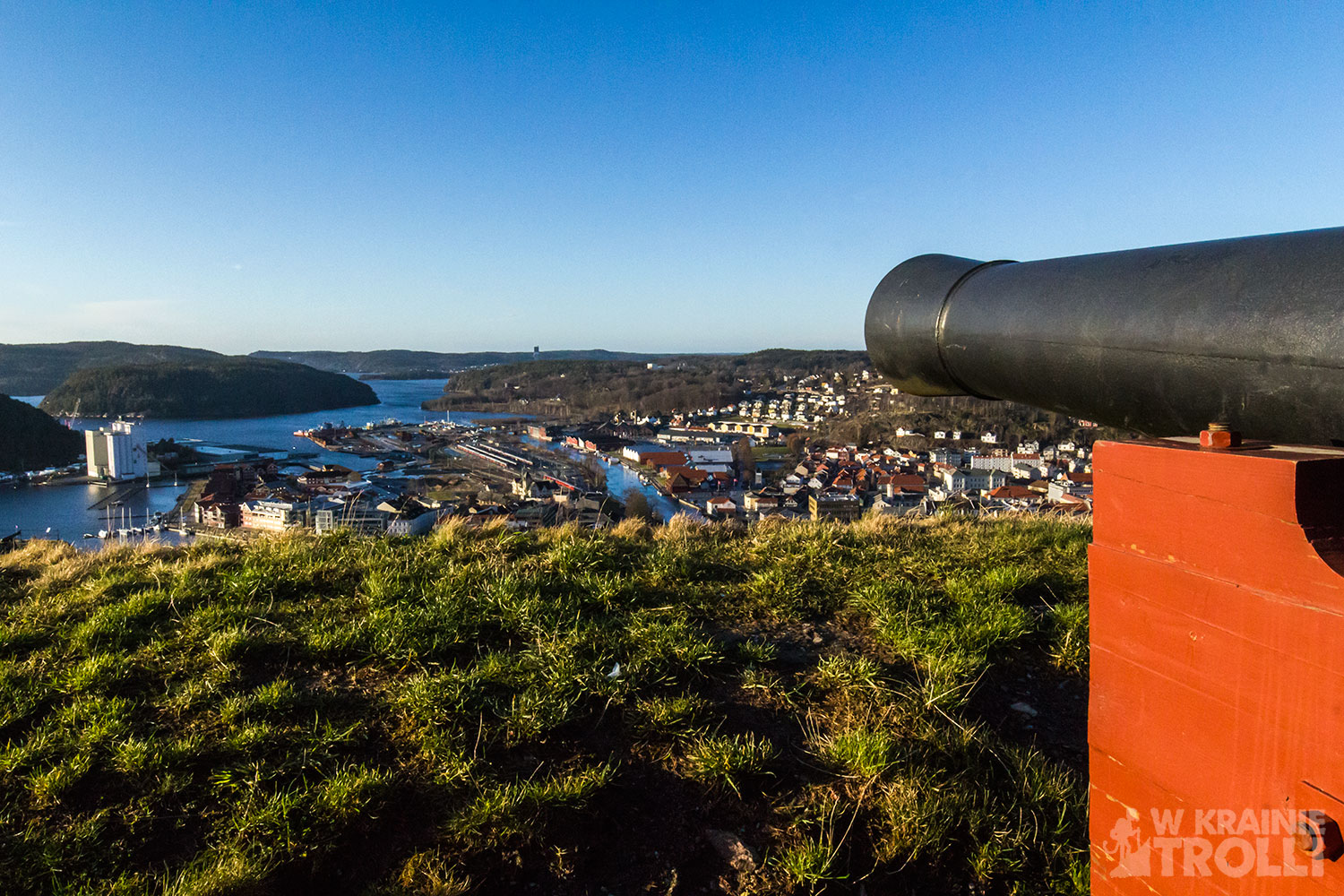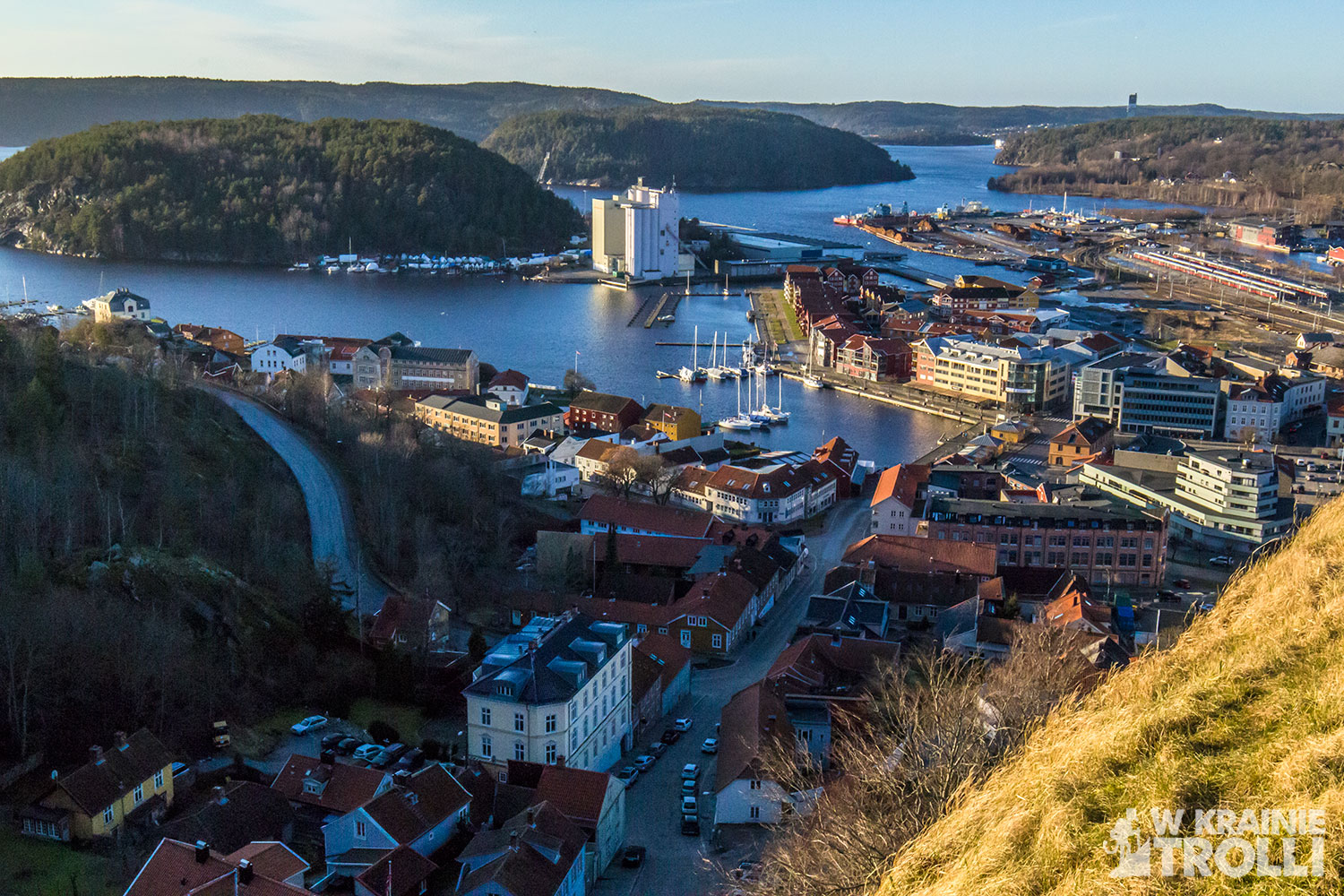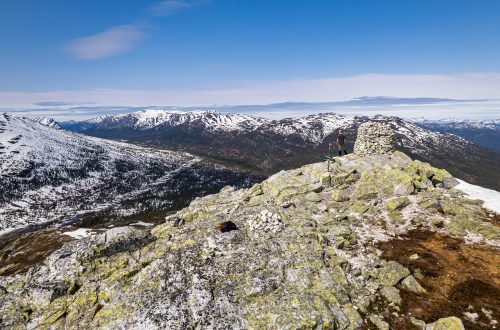
Fredriksten festning
Co można robić, gdy ukochane góry zasypie śnieg a do nart mamy dwie lewe nogi? Najlepiej znaleźć jakąś alternatywę. Najlepiej niezbyt daleko, co by nie trzeba było zbyt mocno eksploatować wiekowego autka. Przeszukując internet w poszukiwaniu okolicznych atrakcji, natrafiłem na przygraniczne miasteczko Halden i jedną z największych w Europie obronną warownię. I już wiedziałem, jak spędzić najbliższą niedzielę. Ale po kolei. Proponuję przenieść się w czasie najpierw do XIV wieku…
Unia z Danią i Szwecją
Od XIV wieku Norwegia i Dania tworzyły jeden twór polityczny (w wyniku królewskiego małżeństwa). Królestwo nazywano Dania-Norwegia a stolicą była Kopenhaga. Znaczenie Norwegii z czasem malało o czym świadczy wprowadzenie języka duńskiego jako oficjalnego języka urzędowego. W roku 1397 do sojuszu przystąpiła Szwecja. Powstałą koalicję nazwano unią kalmarską, od miejscowości Kalmar w Szwecji, gdzie podpisano list unijny. Ośrodek polityczny unii znajdował się w Kopenhadze, wybierany przez wszystkie trzy kraje król oraz urzędnicy dbali przede wszystkim o duńskie interesy co nie zawsze podobało się Szwedom czy Norwegom. Dochodziło do kolejnych buntów, głównie na terenie Szwecji i w roku 1523 kraj ten, już pod rządami nowego króla, Gustawa Wazy, zerwał unię kalmarską.
Norwegia z czasem zupełnie schowała się w cieniu swojego sojusznika a duńsko-norweską monarchię zwano po prostu królestwem Danii. Pomimo podpisania układu pokojowego ze Szwecją, po rozpadzie unii kalmarskiej, konflikt pomiędzy oboma krajami systematycznie powracał. Skutkiem wojny duńsko-szwedzkiej (1643-1645) była utrata na rzecz Szwecji Gotlandii, Ozylii i kilku norweskich prowincji. Kiedy Szwecja zaangażowała się w wojnę z Polską (1657), król Danii, Fryderyk III chcąc wykorzystać nieobecność głównych sił nieprzyjaciela, najechał na Szwecję. Szybko przekonał się jednak, jak bardzo nie docenił przeciwnika. Szwedzki monarcha, Karol X Gustaw, odparł atak i uderzył na półwysep Jutlandzki. Szwecja była wówczas militarną potęgą i gdy tylko jej armia zjawiła się u bram Kopenhagi, Fryderyk III musiał skapitulować. Na mocy traktatu pokojowego z 1658 roku, Dania miała przekazać zwycięzcy Skanię, Halland, Blekingę oraz wyspę Borholm. Norwegia utraciła prowincje Trøndelag i przygraniczny Bohuslän. Pomimo zawartego porozumienia, król Szwecji, Karol Gustaw zaatakował znienawidzoną Danię, rozpoczynając kolejną wojnę. Jedynie dzięki wsparciu sojuszniczych, m. in. polskich wojsk i floty holenderskiej udało się uniknąć ostatecznego podboju.



Bitwa o wały Brådland
Po utracie graniczącej ze Szwecją prowincji Bohuslän i fortu Bohus, stało się jasne, że należy ufortyfikować nowo powstałą granicę między Szwecją i Norwegią. W roku 1659 przystąpiono do dzieła w niewielkiej osadzie Halden. Jednak już rok później Szwedzi pojawili się na miejscu z potężną armią. Bitwa o wały Brådland była niezwykle zacięta. Norweskie siły odpierały szturm za szturmem, ale przy szóstym natarciu Szwedów, musiały wycofać się do miasta. Nie był to jednak koniec starcia. Dowódca norweskiego garnizonu ruszył z kontratakiem i odbił wzgórze, które przez kolejne sześć tygodni było oblegane przez Szwedów. Ci ostatni, pozbawieni zaopatrzenia, wystawieni na niesprzyjające warunki pogodowe, wycofali się na południe. Decyzję odwrotu przyspieszyła wiadomość o śmierci szwedzkiego króla Karola X Gustawa, który zmarł po długiej chorobie w Geteborgu.
Twierdza Fredriksten
Bitwa i oblężenie Halden w 1660 roku pokazały jak ważnym strategicznie miejscem jest to miejsce i górujące nad nim wzgórze. Duński król Fryderyk III postanowił wznieść w Halden potężną i nowoczesną fortecę, zabezpieczając tym samym południową granicę Norwegii przed najazdami Szwedów.
Budowa twierdzy ruszyła w 1661 roku a miasteczko przemianowano na Fredrishald (nazwę Halden otrzymało dopiero w 1928 roku) i nadano mu prawa miejskie. Projektantem twierdzy i nadzorcą budowy został, biorący udział w bitwie o wały Brådland, kwatermistrz Willem Coucheron. Nieregularny kształt twierdza zawdzięcza dostosowaniu murów do ukształtowania terenu. Na wschodzie i południu od głównej cytadeli wybudowano trzy mniejsze, pojedyncze forty (Gyldenløve, Stortårnet i Overberget). Warownię, jak łatwo się domyślić nazwano na cześć króla Fryderyka III. Jest ona największą twierdzą graniczną w Norwegii.





Śmierć króla
Szwedzi nie odpuścili i wracali się pod mury twierdzy dwukrotnie: w 1716 i 1718 roku. Dla szwedzkiego króla, Karola XII, forteca Fredriksten okazała się szczególnie pechowa. W 1716 roku, mieszkańcy miasta podłożyli ogień, pod swoje domostwa aby przepędzić najeźdźców, sami chroniąc się za murami twierdzy. Dwa lata później, gdy król wizytował okopy, przypadkowy wystrzał obrońców twierdzy pozbawił monarchę życia.
Dziś istnieje kilka teorii na temat śmierci Karola XII. Jedna z nich zakłada istnienie zamachowca w szeregach szwedzkiego wojska. Jednak, gdy spytać o to Norwegów, odpowiedzą z dumą, że to ich dzieło. Wielu badaczy skłania się, do teorii, że Karol XII zginął w wyniku postrzału ładunkiem kartaczowym wystrzelonym z działa w forcie Overberget.

Źródło: https://www.forsvarsbygg.no/no/festningene/qr/fredriksten-2/
Jako, że dokładne miejsce śmierci króla nie jest znane, przez lata wzniesiono kilka pomników upamiętniających jego śmierć. Obecny monument, wznoszący się niedaleko fortu Gyldenløve jest siódmym tego typu obiektem na terenie twierdzy.
Wiek XIX i unia ze Szwecją
Niecały wiek później Europą targały wojny napoleońskie, w których Dania wspierała Francję. Na początku 1814 roku, pod naciskiem przytłaczającej przewagi militarnej Szwecji, Prus i Rosji, duński król Fryderyk VI, zaofiarował przyłączenie swego kraju do koalicji anty-napoleońskiej oraz, w ramach odszkodowań wojennych, przekazanie całego terytorium Norwegii Królestwu Szwecji. Sami Norwegowie nie mieli większego wpływu na tę decyzję. O losie całego narodu zadecydowano niejako za ich plecami. Gdy dotarła do nich wieść, że nagle zostali poddanymi króla Szwecji, nie byli z tego faktu zadowoleni. Norwescy nacjonaliści pragnęli pełnej niepodległości dla swojego kraju i jeszcze tego samego roku, 17 maja 1814 podpisano akt norweskiej konstytucji. Ten dzień do dziś obchodzony jest jako norweskie święto narodowe.
Szwedzi dysponowali armią liczącą 65 tysięcy żołnierzy, mieli wsparcie innych europejskich mocarstw i takie obiekcje narodu, który od wieków był schowany w cieniu Danii było dla szwedzkiego monarchy jedynie sygnałem do inwazji. Po fiasku rozmów dyplomatycznych, 29 lipca 1814 roku, Szwedzi zaatakowali Norwegię. Obrońcy twierdzy Fredristen poddali się 4 sierpnia ale zdołali się przeorganizować i połączyć z większymi jednostkami za rzeką Glomma, gdzie doszło do bitwy pod Langnes. Ukształtowanie terenu, grząski grunt po ulewnych deszczach oraz śmiertelny ostrzał kartaczami z norweskich dział uniemożliwiły szwedzkim wojskom zdobycie szańców. Po trzech nieudanych atakach Szwedzi zaprzestali dalszych prób. Było to ważne zwycięstwo, bo choć nie zmieniło ono dysproporcji sił między oboma stronami, dało Norwegii lepszą sytuację wyjściową w rozmowach pokojowych. Szwedom nie udało się wymusić na przeciwniku bezwarunkowej kapitulacji i w wyniku układu pokojowego z Moss (14 sierpnia 1814 roku), ustanowiono unię Norwegii ze Szwecją, w której ci drudzy mieli respektować norweską konstytucję.



Niepodległość
Unia dwóch narodów przetrwała 90 lat, aż do 1905 roku, kiedy to coraz silniejsze dążenia norwegów do niepodległości i popierających ich samych Szwedów doprowadziły do przeprowadzenia referendum w kwestii odłączenia się od Szwecji. 99,95% ludności opowiedziało się za niepodległością. Norwegów popierały również inne europejskie mocarstwa, w tym Wielka Brytania. Szwedzki król Oskar II zrzekł się swoich roszczeń do norweskiego tronu i ten sposób, w październiku 1905 roku, rozwiązano unię, a Norwegia stała się państwem niepodległym. Królem obrano duńskiego księcia Carla, który po koronacji przyjął imię Haakon VII na cześć długiej norweskiej dynastii królewskiej z XIII wieku.
Po roku 1905 twierdza Fredriksten służyła jako siedzba kilku szkół wojskowych. W czasie okupacji hitlerowskiej stacjonowali w niej niemieccy żołnierze. Ostatnią szkołę zamknięto w roku 2005 i od tamtego czasu forteca służy jedynie celom turystycznym i kulturalnym.
Na jej obszernym dziedzińcu organizowane są koncerty i festiwale. Teren wokół warowni jak i same umocnienia są ogólnie dostępne i otwarte przez cały rok, a parking przed twierdzą jest bezpłatny. Muzeum, mieszczące się wewnątrz otwarte jest dopiero od kwietnia, ale w zamian (lub też dodatkowo), przez cały rok, i w dodatku za darmo, organizowany jest po zmroku specjalny świetlny pokaz wyświetlany na murach twierdzy, podczas którego prezentowana jest 350-letnia historia twierdzy Fredriksten. Podczas ważnych dla Norwegów dni, takich jak święta narodowe, bądź urodziny członków królewskiej rodziny, oddawane są z twierdzy saluty wystrzałami armatnimi.
Spędzenie paru godzin na spacerowanie po wałach obronnych i poznawanie historii tego miejsca to świetna alternatywa dla górskich wypraw. Jest to też idealne miejsce na wspólny rodzinny wypad podczas weekendu. Plac zabaw, miejsce na grilla i trzy ciekawie poprowadzone szlaki wokół murów twierdzy mogą skutecznie odciągnąć małe urwisy od ekranów telewizorów czy tabletów.








What can you do when your beloved mountains are covered with snow and you have two left legs for skiing? It’s best to find an alternative. Preferably not too far, to not spend too much time in the car. Searching the internet for nearby attractions, I came across the border town of Halden and one of the largest defensive stronghold in Europe. And I already found out how to spend this Sunday. But first things first. I suggest to move back in time to the fourteenth century …
Union with Denmark and
Sweden
From the fourteenth century, Norway and Denmark
formed one political entity (as a result of a royal marriage). The kingdom was
called Denmark-Norway and the capital was Copenhagen. The importance of Norway
has diminished over time, as evidenced by the introduction of the Danish
language as the official language. In 1397 Sweden joined the alliance. The
resulting coalition was called the Kalmar Union, from the town of Kalmar in
Sweden, where an union letter was signed. The union’s political center was in
Copenhagen, the king and officials elected by all three countries, above all,
looked after Danish interests, which the Swedes and Norwegians did not always
like. There were further revolts, mainly in Sweden, and in 1523 the country,
already under the rule of the new king, Gustav Vasa, broke the Kalmar union.
Over time, Norway completely hid in the shadow of
its ally and the Danish-Norwegian monarchy was simply called the kingdom of
Denmark. Despite the signing of a peace agreement with Sweden, after the
collapse of the Kalmar Union, the conflict between the two countries was
systematically returning. The consequence of the Danish-Swedish war (1643-1645)
was the loss of Gotland, Ozylia and several Norwegian provinces to Sweden. When
Sweden got involved in the war with Poland (1657), the King of Denmark, Frederick
III, wanted to take advantage of the absence of the main enemy forces, invaded
Sweden, but he became convinced that he underestimated the opponent. The
Swedish monarch, Charles X Gustav, resisted the attack and struck the Jutland
peninsula. Sweden was then a great military power and as soon as its army
arrived at the gates of Copenhagen, Frederick III had to capitulate. Under the
peace treaty of 1658, Denmark was to hand over to the winner Skania, Halland,
Blekinga and the island of Borholm. Norway lost the provinces of Trøndelag and
the border Bohuslän. Despite the concluded agreement, the King of Sweden,
Charles Gustav, attacked the hated Denmark, starting another war. Only because
of support of allied forces, among others Polish troops and Dutch fleet,
Denmark managed to avoid the final conquest.
After losing the order province of Bohuslän and fort Bohus, it became clear that the newly created border between Sweden and Norway should be fortified. In 1659, work began in the small settlement of Halden. A year later, the Swedes arrived with a powerful army. The battle for Brådland embankments was extremely fierce. Norwegian forces defended fifth attacks, but at the sixth Swedish assault they had to retreat into town. However, this was not the end of the battle. The commander of the Norwegian garrison launched a counterattack and recaptured the hill, which was besieged by the Swedes for the next six weeks. Finally, because of lack of supplies, exposed to cold and in fact that the swedish King Charles X Gustav died after a long illness in Göteborg, swedish army retreated to the south.
Fredriksten fortress
The battle and siege of Halden in 1660 showed how strategically important this
place is. The Danish king, Frederick III decided to erect a powerful and modern
fortress in Halden, to protect the southern border of Norway against Swedish
invasion.
Construction of the fortress began in 1661. The town was renamed to Fredrishald
(it changed to Halden in 1928) and was granted city rights. Quartermaster
Willem Coucheron, who took part in the battle for embankments Brådland, was the
designer of the fortress and supervisor of the construction site. The irregular
shape of the fortress is due to the adaptation the walls to the terrain on the
hill. To the east and south of the main citadel, three smaller, single forts
(Gyldenløve, Stortårnet and Overberget) were built. The stronghold, as you can
guess, was named after the king of Denmark, Frederick III. It is the largest
border fortress in Norway.
Death of the king
The Swedes did not give up and returned to the fortress walls twice: in 1716
and 1718. For the Swedish king, Charles XII, the fortress of Fredriksten turned
out to be particularly unlucky. In 1716, town residents set fire to their homes
to drive out the invaders, protecting themselves behind the fortress walls. Two
years later, when the king visited trenches, an accidental shot of defenders of
the fortress deprived the monarch of his life.
Today, there are several theories about the death of Charles XII. One of them
assumes the existence of a assassin in the ranks of the Swedish army. However,
when asked the Norwegians about it, they will answer with pride that it is
their work. Many researchers are inclined to the theory that Charles XII was
killed by a canister shot from Overberget Fort.
As the exact place of the King’s death is unknown, several monuments were
erected to commemorate his death. The present monument, rising near the
Gyldenløve fort, is the seventh of its kind in the fortress.
19th century and union with Sweden
Less than a century later, Europe was torn by Napoleon wars, in which Denmark supported France. At the beginning of 1814, under pressure from the overwhelming military superiority of Sweden, Prussia and Russia, the Danish king Frederick VI offered to join his country to the anti-Napoleon coalition and, as part of war compensation, handed over the entire territory of Norway to the Kingdom of Sweden. The Norwegians themselves did not have much influence on this decision. The fate of the whole nation was somehow decided behind them. When they realized that they had suddenly become people of the King of Sweden, they were not satisfied with this fact. Norwegian nationalists wanted full independence for their country, and in the same year, on May 17, 1814, the Norwegian constitution was signed. This day is celebrated as a Norwegian national day.
The Swedes had an army of 65,000 soldiers, they had the support of other European powers and a nation that had been hidden in the shadow of Denmark for centuries now has some objections was only a signal for the Swedish monarch to invade. After the fiasco of diplomatic talks, on July 29, 1814, the Swedes attacked Norway. Defenders of the Fredristen fortress surrendered on August 4, but they managed to reorganize and merge with larger units beyond the Glomma River, where the Battle of Langnes took place. Terrain, muddy ground after heavy rains, and lethal cannon fire from Norwegian cannons prevented Swedish troops from getting ramparts. After three unsuccessful attacks, the Swedes stopped further attempts. It was an important victory, because although it did not change the disproportion of forces between the two sides, it gave Norway a better starting position in peace talks. The Swedes failed to force the opponent to unconditionally surrender, and as a result of the peace agreement with Moss (August 14, 1814), a union of Norway with Sweden was established. The Swden agreed to respect the Norwegian constitution.
Independence
The union of two nations lasted 90 years, until
1905, when the increasingly stronger aspirations of the Norwegians for
independence and the supported them Sweden citizens led to referendums on the
issue of secession from Sweden. 99.95% of the population said yes of
independence. Norwegians were also supported by other European powers,
including Great Britain. The Swedish king Oscar II waived his claims to the
Norwegian throne and in October 1905 the union was dissolved and Norway became
an independent state. The Danish Prince Carl was elected for king and he, changed
the name after the coronation to Haakon VII in honor of the long Norwegian
royal dynasty from the 13th century.
After 1905, the Fredriksten fortress served as home
for several military schools. During the Nazi occupation German soldiers were
stationed there. The last school was closed in 2005 and since then the fortress
has only been used for tourist and cultural purposes.
Concerts and festivals are organized in its
spacious courtyard. Terrain around the stronghold as well as the fortifications
themselves are publicly available and open all year round, and parking in front
of the fortress is free of charge. The museum, housed inside is closed for
winter, but instead of it (or in addition), throughout the year, a special
light show is displayed on the walls of the fortress after dark, during which
the 350-year history of the Fredriksten fortress is presented. During important
days for Norwegians, such as national days or the birthday of members of the
royal family, salutes are fired from the fortress’s cannon.
Spending a few hours walking along the ramparts and learning about the history of this place is a great alternative to mountain expeditions. It is also an ideal place for a family get-together during the weekend. A playground, barbecue area and three interesting trails around the fortress walls can effectively pull the kids away from TV screens or tablets.




